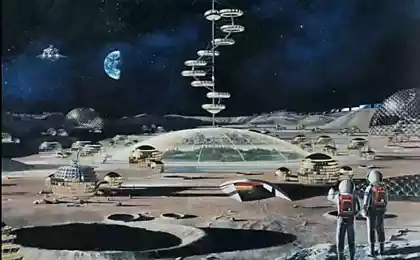
"Luna-9" was the first machine that made a soft landing on another celestial body. But less well known is that the "Luna-9" was the twelfth in a series of devices with a soft landing. And if not for the accident, the first soft landing would take place three years earlier, in 1963. What happened to the previous eleven computing, and what can be learned from this?
Materiel h4> To make it clear which nodes refused where it is necessary to understand the structure and terms of the flight of interplanetary station program E-6. In terms of flight the following stages:
Withdrawal

Overclocking to the Moon
The flight to the Moon
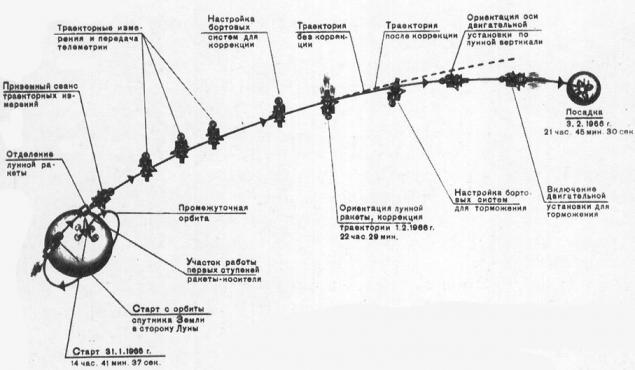
Landing
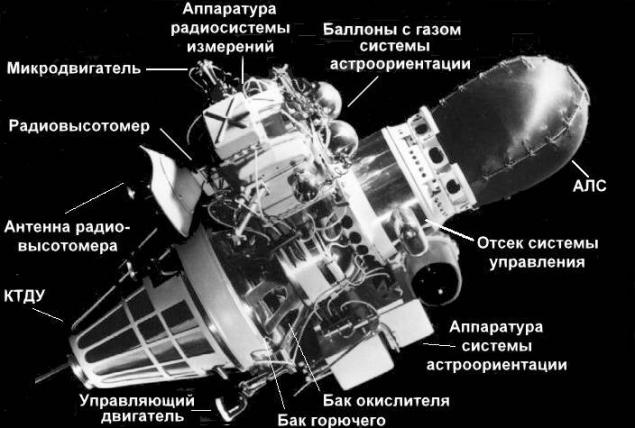
orientation i>. The trajectory of the flight is designed so that its last portion is perpendicular to the surface of the moon. Using the Sun, Earth and Moon as beacons, the station is oriented along the trajectory.
Brakes i>. Brake motor (KTDU) includes 75 km to the surface of the Moon on the team radio altimeter. During braking dropped when no longer blocks (less weight - easier to slow) and inflated rubber cylinders, shock absorbers.
Contact i>. After the main session braking KTDU turned off, and the station declined to drive the motor at low speed. Pull the dipstick recorded contact with the Moon on which the lander inside the cylinders, shock absorbers shot from the brake chamber.
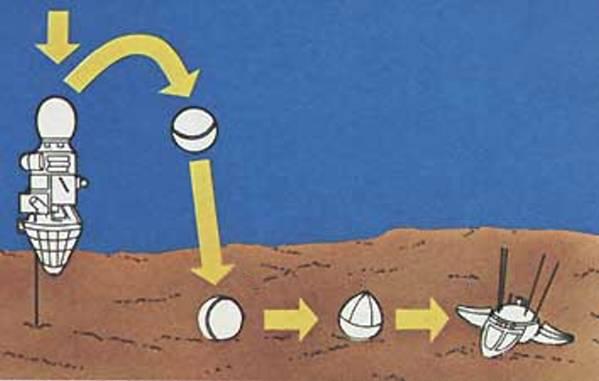
Enable i>. Once the "ball" stopped jumping on the moon, cylinders, shock absorbers were dropped, and the lander petals opened protective top, and then the antenna.
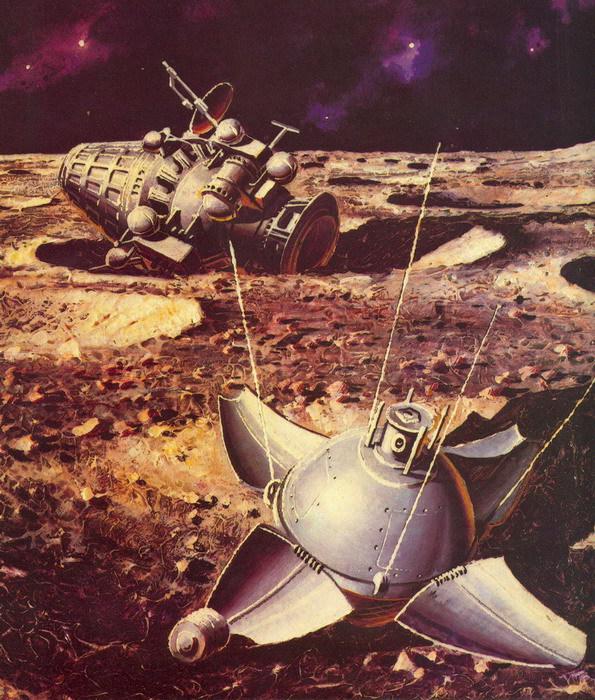
The transmission of information i>. The main purpose of the station - the panorama of the lunar surface. Therefore, the main scientific instrument has been to rotate the camera in a sealed transparent container.
The story, though, picture, somewhat dry. Fortunately, there is a great Soviet film tells about construction and flight stations:
Scenario "Luna-9» there Orbiter'e , but who are too lazy to put, there is a good explanation of the plan of flight video: < br />
Crash h4> Now that more or less clear design and plan the flight station, we can talk about what, where and why broke.
Initial Conditions h5> The missile 8K78 "Lightning" has made ten starts before the beginning of the fly on the program of E-6. Of these, only one start all four stages worked normally. The fault of the fourth stage was 5 accidents, the third - 2, and the first / second - 2. This is due to the terrible statistics of rocket and artillery approach to test spacecraft in the USSR, multiplied by the policies of the space race. First, the designers came from artillery and rocket, it was customary for them to make a lot of starts, debugging devices already on the results of emergency starts. Immediately it should be noted that to solve space problems, this approach turned out to be unsuitable - the price of one start and the money and time spent is much greater than the price of a thorough ground testing and testing. Secondly, the prestige of sending interplanetary probes to Mars and Venus led to thinking "made - immediately start, maybe fly away." Naturally, the results show that the "random" does not work.
Also, it should be noted that the analysis of the causes of accidents produced bad. The fact that the launch of the fourth stage took place over Atlantichekim Ocean between South America and the coast of Africa, and the station could not transmit telemetry to the territory of the Soviet Union because of the curvature of the Earth. Therefore, the exact cause of the five bounce fourth stage was unknown. By the beginning of the program launches E-6 special ship 'Dolinsk "was sent to the Gulf of Guinea in order to receive telemetry and to transmit it to the MCC that there could learn about the cause of failure.
A simple calculation shows that, in such circumstances, the likelihood of a successful start-up is 10% (1 successful / 10 total). Although, if you think about it, it tends to 0 because of the failure of the fourth stage, the cause of which is unknown, and problem determination was carried out at random.
First start h5> January 4, 1963, the first launch of the program E-6. The accident, the failure of the fourth stage. Ship 'Dolinsk "was already in position and managed to get telemetry. The immediate cause of the accident was the failure of an electrical command to start the engine (some sources indicate that it was the deposition engines, which were used for main engine start). The reason for this failure of current transducer called block control system. The block was filled with dry nitrogen, causing increased wear of the brush collector motor. Despite the fact that during the test packs are generally out of order for a long time, other possible causes have not found. As a solution, nitrogen began to moisturize and add a little bit of oxygen.
Reason
Solution
The second launch h5> February 2, 1963. The accident at the site of the third stage of the rocket off course and fell into the Pacific. The reason was improperly installing gyroscopes control station, which, as you remember, and manages the third stage of the launch vehicle. In fact, the third stage already at the start was aimed into the ocean. It was also revealed a lack of precision gyroscopes, as different from the actual trajectory programmed.
Reason
Solution
The third start h5> April 2, 1963. All four stages are activated successfully, the station is sent to the Moon under the name "Luna-4". The accident comes at a stage of issuing a corrective pulse midway station missed the moon. Cause of the accident - the refusal of celestial navigation. The immediate cause of the accident has not been established reliably, celestial navigation system unit has received many comments. It is characterized by surprisingly Commission described at Chertok: «Where were you before? In order to detect such a complex system in dozens of defects does not necessarily fly to the moon. All this is evident in the low-cost laboratory and factory audits » i>.
Reason
Solution
The fourth start h5> March 21, 1964. The accident at the site of the third stage - do not open the main oxygen valve, the third stage does not start. The reason - the break of the valve stem, all the valves for the third stage had to refine
Reason
Solution
Venus helped h5> March 27, 1964 held the launch of rockets 8K78 with interplanetary station Venus. Again, not including the fourth grade, but, because it stood on the new recording device, data were obtained on the sequence of events when the engine is started. It was found that the control system designers have not considered the fact that the power switches (relays) switch is not instantaneous. Because of the delay valve actuation switch is not receiving power and is not included. The fourth stage is not able to orient and tumbled to the intermediate orbit.
Tellingly, in the world the problem was fixed within 20 minutes of a soldering iron.
Reason
Solution
The fifth start h5> April 20, 1964. The accident, the failure of the fourth stage, the engine not starting. Telemetry records the absence of a signal to the system to ensure the engine starts. Again being tested control system I-100 and PT-current converter 500. Laboratory tests show that, despite the overall satisfactory operating temperature and 100, some parts are subjected to unacceptable local overheating. The unit was sent back for revision, also, before the start it began to cool.
Please note that the immediate cause of the accident coincides with the first start-up, and the reason for this failure again is not clear until the end. Problems with the unambiguous establishment of the causes of failures led to the conflict between developers adapter (PT-500, the chief designer Iosif'yan) and power management system (I-100, the chief designer Pilyugin).
Reason
Solution
The sixth start h5> 12 March 1965. The accident, the failure of the fourth stage, the engine not starting. Regular laboratory tests on a background of strained relations between the designers. Staff checked on stand Pilyugina transmitter PT-500 Iosif'yan, and, after several hours, find the possible cause - balancing the puck can touch the cover fixing screw, which, in their opinion, overload and disables the engine. Commission Decision of emergency PT-500 is replaced with two transmitters PT-200, the same production Iosif'yan, but older and already familiar.
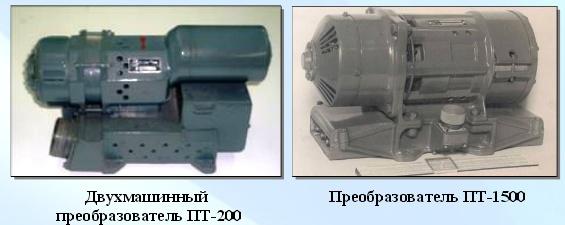
Photo PT-500 is not found, the PT-1500 from the same series, only three times more powerful i>
Reason
Solution
The seventh start h5> April 10, 1965. Serial number of stations reached a figure 8, and the officers home team grimly joked "Number eight is not to throw the Moon." The joke turned out to be true - an accident, failure of the third stage. The reason - violation of the engine due to the failure of the tank pressurization.
Reason
Solution
The eighth start h5> May 9, 1965. All four stages worked fine, and the station went to the moon called "Moon-5." However, half way through any problems - with the algorithm of the control system was given too little time to warm up gyros. Because of this, once I broke a trajectory correction maneuver (was still made for the third time) and braking maneuver broke the Moon. The station broke the surface of the moon.
Reason
Solution
The ninth start h5> June 8, 1965. The station is successfully launched to the Moon under the name "Luna-6." The mission had failed because of the fact that during the trajectory correction does not turn off the engine and burned all the fuel. The reason was an error in the sent to the "board" commands from Earth - forgot to specify the length of the engine. Station flew past the moon.
During the flyby of the moon by the station it was used for testing of the assembly, those who could experience (boost dampers, etc.) What is important - has been received a considerable amount of the comments.
Reason
Solution
Tenth start h5> 4 October 1965. The station is successfully launched to the moon as a "moon-7" and got no problems before the session began braking. The station switched to telemetry in real time, MCC sounded reports: "There is the construction of the lunar vertical", "Go radio altimeter measurements - to the moon five thousand kilometers," "To the moon four thousand kilometers." Half an hour later made a report: "Joined the loss of the Earth." Loss of land meant astroorientation sensor lock brake motor. The station broke the surface of the moon. The cause of accident was an error when installing the sensor corners of the Earth - Earth fell on the edge of the sensor, and the slightest disturbance meant the loss of orientation. Parallel observations have been made to the hardware construction of the lunar vertical.
Reason
Solution
Eleventh start h5> 3 December 1965. The station was launched to the Moon, becoming the "Moon-8." For greater certainty, shortly before the braking was held a session of "false corrections" when the team from the earth station included astroorientation and oriented in space, but it does not include a brake motor. However, in the course of the session after the boost brake cylinders, shock absorbers station lost height measurement. According to reports, the station began to spin, and the altimeter "lost" the moon that blocked the inclusion of engine braking. The engine involved only 9 seconds to contact, and the station crashed into the moon at an unacceptable rate.
Disorientation after the boost damper cylinders made prime suspects. Five days of experiments discovered the reason - when supercharged cylinders rest against the fiberglass antenna mounting bracket, which is broken down to form a sharp edge that pierced cylinders and leakage of them led to loss of orientation. The reason for breaking an arm - a violation of manufacturing technology, incorrect installation in the blank mold. This cause is listed in the "Rockets and People" Chertok. At the same time there is an alternative version - boost cylinders caused the disturbance, which could not handle the system focus on gas engines. In this case, the solution was transferred to the boost cylinder engine braking area of work where headroom for stabilization was.
Reason Smorkalov ).
Solution
Twelfth start h5> January 31, 1966 the station "Luna-9" was successfully launched, and February 3, 1966 prilunilas successfully for the first time in the world. The station was held seven sessions, and the photos were built panorama of the lunar surface:

where you can see three larger panorama.
Analysis h4> Consider the causes of accidents of this program (not including the launches of the same media with other PN). In place of a fault:
The third stage
The fourth stage
station
Earth
It turns out that half of the station simply "did not reach all" - a node fails, it worked before. Separately, it should be noted problems with the 4 stage (block "L"), which stubbornly "wanted" to work as it should. In case, if the station still comes around, she refuses to two thirds of the cases. In this analysis of the accident shows the overwhelming predominance of structural defects that can be identified and eliminated during ground tests, if they were carried out with sufficient care. This statistic clearly demonstrates unfitness for space method of mining products as a result of consistent improvements in accidents.
Implications for IT h5> In IT, there are different areas where something could well have a program, even with critical bugs, but it is always to balance the cost of testing a certain level, coverage and quality losses from bugs (decrease reputation with users failures of customers, contractual penalties, etc.).
It is also helpful to understand that if there is a sequence of elements, each of which should work well for the overall success, there is no point in re-testing to debug the intermediate element. Simply put, not yet have a high reliability of the "fourth stage" no sense "to send the station to the Moon».





















